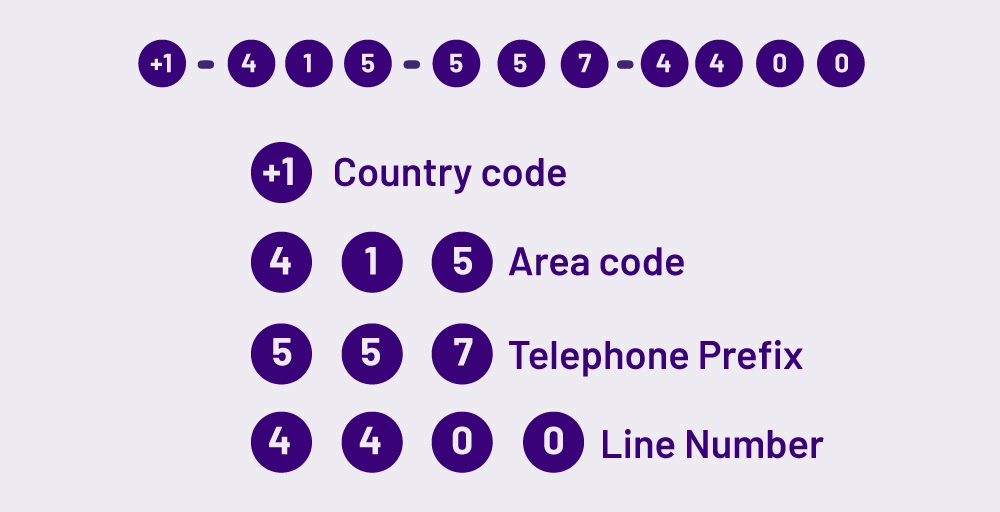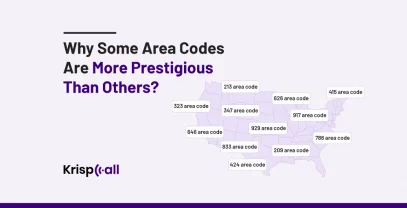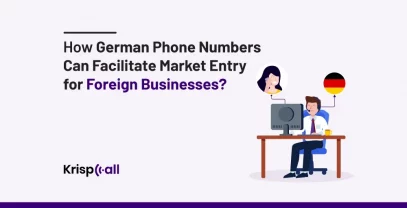How many times a day do you use your phone to call others?
According to Sellcell, an average person makes a phone call 7-8 times a day. First, You likely dial a country code, such as (1), and a three-digit area code, like (977), and then place the remaining numbers.
But, what are those remaining numbers called? In the telecommunication world, they are known as the Telephone Prefix and Line Number, and they play a vital role in connecting phone numbers from one place to another.
In this article, you will learn different parts of phone numbers like country and area codes, telephone prefixes and line numbers, phone number formats, and the importance of phone number structure in communication.
Let’s get into it. 👇
🔑 KEY HIGHLIGHTS
- Phone numbers have different parts that serve specific functions to route calls accurately – country code, area code, telephone prefix, line number.
- Country codes identify which country a phone number belongs to. Area codes guide calls to broader regions within a country. Telephone prefixes further narrow numbers down to specific towns/cities. Line numbers precisely pinpoint the individual phone line being called.
- Understanding the format used in your country is important for placing local calls correctly. The international format starts with “+” followed by the country code to signal an international call.
- Standardized number formats like E.164 are essential for international connectivity and large-scale data management by phone companies. It provides a universal language for phones worldwide.
What are the different parts of a phone number called?
A phone number mainly consists of 4 parts: the Country code, Area code, Telephone Prefix, and Line Number. The parts of a phone number serve their own function. Here are the different parts of a phone number:

1. Country Code
A country code is 1 to 3 numbers showing a phone number’s origin.
- The “+” symbol indicates a long-distance call across places, alerting networks to move the call between areas.
- The US and Canada start numbers with “1”, so you know if a number is from there.
- Each country uses its own number at the beginning that, along with more digits, smoothly directs calls anywhere globally.
2. Area Code
An area code in a phone number is a 3-digit number that shows the broader region of a country in which a number is located. They direct calls to broad zones that may include multiple towns or cities. Big cities sometimes have multiple area codes.
Special codes also have specific functions. For example, Numbers starting with 800 are toll-free long-distance calls, Local area codes only work in certain districts, and 900 codes are for numbers you pay to call.
Area codes efficiently guide calls within countries by identifying larger geographical areas numbers come from. Special codes also let you know what type of call or service a number is for.
3. Telephone Prefix
After the area code comes 3-4 number telephone prefixes; these prefixes pinpoint exact towns and cities within the larger area code region. If two numbers share a prefix, you don’t need the area code to call between them. This is because prefixes identify numbers as being in the exact same place.
Phone companies use the prefixes to route local calls within an area code. They don’t need the broader area code since prefixes specify the location accurately on their own for these intra-area calls.
Prefixes play an essential role in further narrowing down the numbers. When prefixes match, they show specific towns and allow local calling without area codes.
4. Line Number
The last 4-6 digits are called the line number. This directly points to the exact phone being called. It allows for a lot of number combinations for businesses to advertise.
The line number is the final piece that precisely routes a call to the intended phone to ring within seconds. All the sections of the number work incrementally to accurately direct connections up until the targeted line is reached, with the line number pinpointing the specific receiver at the end.
For example, a full 10-digit phone number for someone in Philadelphia would be 1-215-555-1234.
Here is the phone number breakdown:
- 1 is the US/Canada country code
- 255 is the Philadelphia region area code
- 555 telephone prefix plus line number
- And 1234 pinpoint the exact phone line
Understanding Phone Number Formats
Phone numbers are formatted differently depending on whether you are calling within your country or internationally. Understanding your country’s format is essential for placing calls correctly.
Calling Within Your Country: The Standard Format
All countries have their own format for calls within their country borders. In other places worldwide (such as Canada), you’ll recognize phone numbers with eleven digits (which often have parentheses and dashes to make them easy to read). E.g. +1 (416) 555-1212.
Some other nations adopt a different number of digits or may not use separators. It is pretty important to understand the format used in your area to dial local numbers properly.
Reaching Across Borders: The International Format
To make an international call, you must use a different code to get to the right place. The E. 164 standard, created by the International Telecommunication Union, defines a worldwide language for phone numbers. It starts with a “+” (plus sign) followed by the country code, which is a unique identifier of each separate country (e.g., +1 for the US).
It may include a national destination code following the initial code, similar to the area code and the local phone number inside the country you are calling next. With this format, your calls abroad go seamlessly without any risk of confusion at the international portals.
What is an Exit Code and Country Code?
Exit codes and country codes are essential for calling people in other countries. Exit codes tell your phone company that a call needs to go a long distance, and country codes say which country the call is going to.
Exit Code
An exit code is a group of numbers you enter before a phone number when making an international call. This tells your phone company the call needs to go to another country.
Exit codes are different in each country. Most are 2 or 3 digits long using 0s and 1s. The most common is “00”, used by over 200 places like the UK, France and Germany. Russia’s is 810, and America’s is 011.
No matter where you call from, entering “+” means the call goes internationally. This signals your company to add the proper exit code so the call goes to the right place.
Putting “+” and the country code makes remembering how to call other countries easy. Your company just needs the country code to know where to send the call. This simple system works well worldwide for calling friends and family abroad.
Example: 00 (exit code) 61 (Australia) 7 (area code) 87654321 (phone number)
Country Code
Country codes come after the exit codes or “+” sign. They tell where the incoming call needs to go country-wise. Unlike exit codes, each country code picks out one destination only.
When you make an international call, dialing the country code first routes the call to that place. Often, the country code replaces the first 0 when calling within the same country.
Without country codes, phone service providers would need another way to know where calls are headed. However, entering “+” and the country code works great. This allows people just to remember the code for each country instead of multiple numbers.
It makes calling internationally easy while efficiently sending all calls to the right place worldwide. Dialing “+” and the country code simplifies connecting with friends and family across borders.
What Does +1 in Front of a Phone Number Mean?
The “+” sign serves as the universal sign for international calls. The numbers after it tell what country the call is going to. For example, “+1” means the US, “+44” is the UK, and “+34” is Spain.
Storing contact numbers in the “+” format means they can be dialed from anywhere in the world. Without it, the number might only work when called with special codes from certain countries.
For example, a UK number like “xx-yyyy” works anywhere if saved as “+44-xx-yyyy.” But saved as “011-44-xx-yyyy,” it can only be called from America. The “+” makes international dialing easy and consistent everywhere, making it easy to connect with people all over the globe.
What is area code in a phone number?
Area codes are groups of 3 numbers added to the front of 7-digit phone numbers. They help phone companies route calls correctly.
When you call someone in another state, dialing their area code first is important. Phone networks use area codes to know which local company serves that number. That local company then connects the call.
For example, if you’re calling a friend in California from New York, entering the California area code 415 or 510 tells phone lines you want the call in California. This lets the call follow the path to the right local provider in California, who then delivers to your friend’s number. Area codes make sure long-distance calls between states go to the correct location.
What is a Telephone Prefix?
A telephone prefix is the first three digits after the area code in a phone number. Sometimes called an exchange code, it acts like a label on groups of wires.
So, when calling a friend locally, you would dial the area code first to indicate the general region. Then, the prefix further narrowed it down to the specific switchboard handling phones in your friend’s neighborhood. The last four digits of their number would connect the call directly to their line within that grouped section.
The prefix is the first three digits after the area code. For instance, in the phone number (212) 555-1212, “212” is the area code to call New York , and “555” is the prefix.
What is the Line Number in a Phone Number?
The last four digits of a phone number make up the line number, uniquely identifying a specific device within an area code and prefix. At the same time, the area code and prefix indicate the general location, and the line number singles out the exact individual or business being contacted.
Like house addresses, each line number corresponds to a single device, so dialing that unique sequence ensures the intended party receives the call.
Some companies opt for vanity numbers that are more memorable than standard line combinations, like 1-800-CALL-ATT. Prefixes and line numbers generally provide the greatest flexibility for customization.
What is the importance of Phone Number Structure in Communication?
Even though a phone number structure may look minor, its role is very important. Here’s why it matters:
Efficiency and Accuracy
Phone numbers within a country must follow the same basic format. Imagine if everyone wrote numbers differently—with changed symbols or in another order. You might write a number wrong by missing a dash or adding an extra mark. The call wouldn’t go through because the phone company records the number differently. A set structure for numbers in each place means everyone dials the same consistent way.
This organized system lets calls be ordered and directed quickly without errors. Phone companies can correctly route numbers when everyone follows the same format. Uniform numbering prevents mistakes that would cause a call not to connect, enhancing efficiency and accuracy.
International Connections
The international E.164 number format is a universal language for phones worldwide. Sending a letter without an address is like sending a letter without a post office —the post office wouldn’t know where to deliver it. The standardized number structure guarantees international calls are placed correctly. It ensures the call reaches the right country first, then the right city within that country, and finally, the specific phone number at the destination.
The E.164 format properly guides phone calls, like an address route mail. Providers wouldn’t know exactly where to send an incoming international call without it. The number structure acts like directions, so calls are delivered precisely where intended anywhere in the world.
Data Management
It’s really important for companies and groups to use the same phone number format, consistency makes sure there are no mixed-up or repeated numbers. Standardized formatting guarantees numbers are written the same way every time without mistakes. This ensures easy finding and contacting of the right people. Keeping track of everyone’s contacts would be hard if numbers were recorded differently each time.
The uniform structure keeps extensive collections of phone numbers neat and clear. Businesses can then locate and connect with customers, suppliers, and others quickly and accurately. Consistent formatting is vital for large organizations to manage all their essential contact data efficiently.
Conclusion
Country codes identify which country a number is from, whereas exit codes help you make calls when you are abroad. Area codes divide calls to bigger areas, prefixes refer to specific settlements or places within a larger region, and Line numbers are used to locate the individual phone.
Generally, Mobile numbers use essentially all these parts, like a set of directions. They set up systems that display the country, region, town, and line being called. Phone network numbers also fulfill a similar role globally by routing calls to the right place. Even as the number of phones grows, these parts of numbers are a guide, helping every call reach its destination smoothly and get in touch regardless of their location.
If you want a virtual phone number with a standardized phone number format, then you can sign up for KrispCall. KrispCall offers you 24/7 dedicated human support, 99.99% uptime, a massive pool of virtual numbers spread across 100+ countries, and excellent communication tools.





